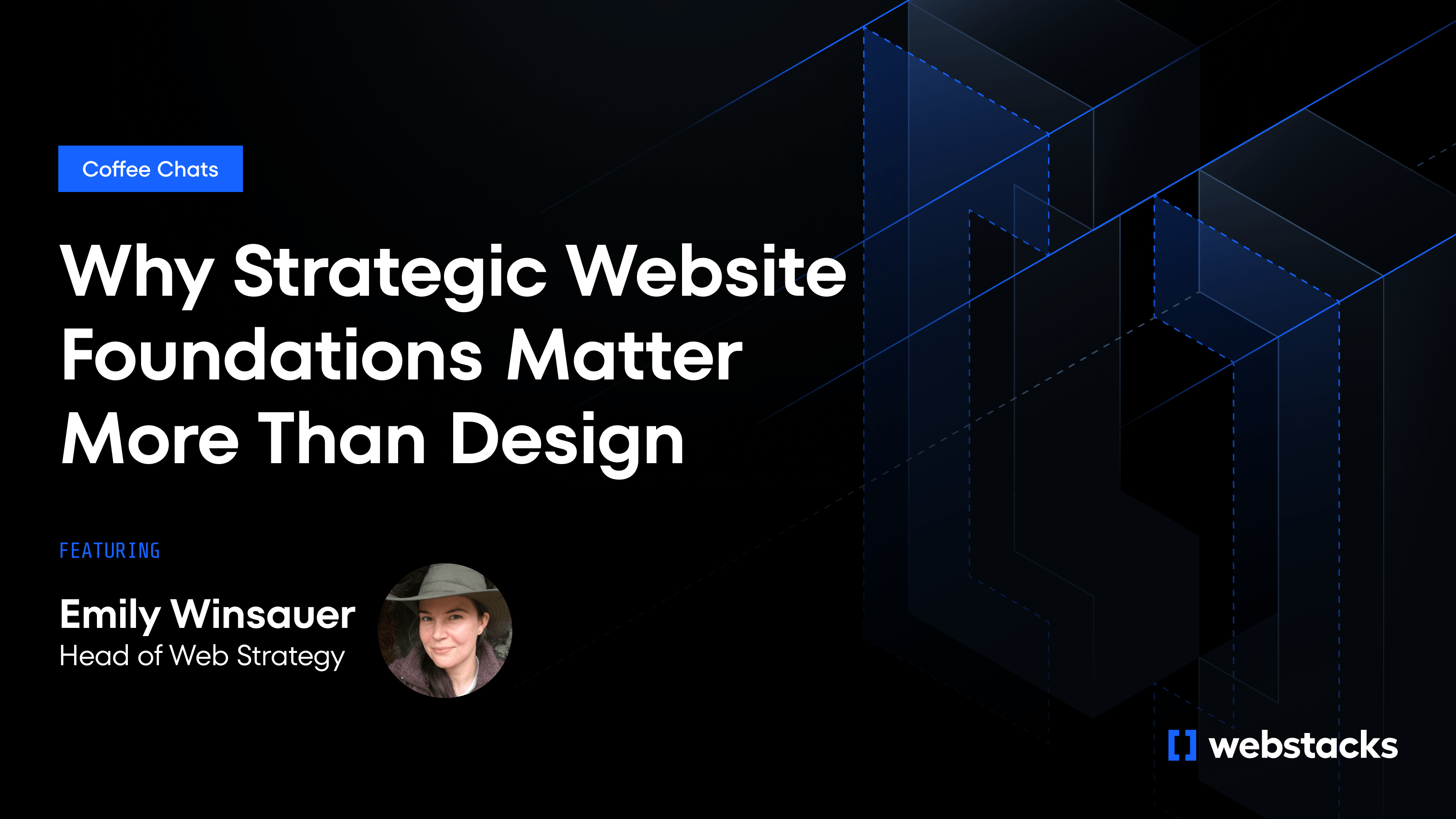Most crypto teams don’t start with a content strategy. At the beginning, it’s usually a few tweets, a landing page, maybe a blog post or two. That’s fine when you’re building. But once users show up, or investors start asking questions, that superficial approach starts to break.
A crypto content marketing strategy helps people learn how to use your product, trust your vision, and stick around. Whether you’re targeting developers, DAO contributors, or new token holders, your content has to do the hard work.
This guide walks through how to make that happen. We’ll show you what crypto content is, how to build a strategy, pick content formats that work, and set up a system that’s easy to scale. You will also learn how Webstacks helps crypto teams clean things up so they can ship faster.

What Is Crypto Content Marketing?
Crypto content marketing is the practice of creating and distributing educational, informative, and engaging content to attract and support the various users of a blockchain product or ecosystem. It spans everything from technical documentation and blog posts to tutorials, governance updates, and community explainers.
What makes this different from traditional content marketing is that you’re often talking to multiple audiences, such as developers, retail users, validators, and LPs.
Some are knowledgeable, while others might have no idea what a gas fee is. And unlike SaaS, most crypto teams are building in public. So your content has to work harder to educate, build trust, and adapt fast when things change.
Speed is another factor. Token launches, governance votes, and protocol updates move quickly. Without flexible content systems, teams fall behind and users lose clarity.
Crypto content may look different, but the goal stays the same: help the right people understand, adopt, and grow with your project.
The Importance of a Good Content Strategy for Crypto
Strong content starts with clarity. Before choosing formats or channels, take a step back and align on what you're trying to achieve and who you're trying to reach.
Are you onboarding developers? Encouraging staking? Explaining a cross-chain integration?
Each goal calls for different content types, tone, and distribution methods. Without that alignment, it's easy to create content that looks polished but doesn’t help users take action or move the project forward.
Here’s a simple way to structure your strategy:
- Define the goal of your content strategy, such as increasing organic traffic or signups
- Define the key actions you want users to take
- Identify the audiences tied to those actions—are they developers, token holders, governance participants, or partners?
- Create content that supports those users in making the right moves
From there, map out what each audience needs to know, believe, and do at each stage. That becomes your content framework.
If you're focused on developers, you’ll likely need integration guides, tutorials, and code samples. If you're driving product adoption, it might be more about explainers, onboarding flows, and use case content.
When teams skip content strategy, their content gets scattered and hard to scale. At Webstacks, we help clients ground their content in their GTM model so every piece has a purpose.
3 Content Types That Work in Crypto
It’s easy to fall into the trap of just posting content to stay visible. Here’s what works, based on where your audience is and what they need from you:
1. Developer-Focused Content
If developers are your users, treat your content like part of the product. They care about how things work. Focus on:
- Integration guides, SDK walkthroughs, and code samples
- GitHub README best practices and developer FAQs
- Video demos and live coding sessions
2. Thought Leadership That’s Useful
Thought leadership only works if it teaches something. Skip the vague vision posts and focus on:
- Clear explanations of how your product fits into the bigger picture
- Deep dives into technical challenges you’ve solved
- Market trends that matter to your community or partners
3. Community and DAO Content
If your project includes a DAO or community voting, content is how you keep people informed and engaged. Useful formats include:
- Proposal summaries and voting guides
- Contributor recaps and bounty callouts
- Monthly digest posts that connect the dots
Content Distribution Strategies for Crypto
Most crypto teams stick to X, Discord, or maybe Mirror. That’s fine for reaching the loudest users. But it’s not enough if you want developers, partners, or researchers to find and use what you’ve built.
Think about spreading your content like this:
- Web3-native platforms like Farcaster, Lens, and Mirror
- Crypto newsletters for sponsored posts or content features
- Developer forums like Stack Overflow, Dev.to, or your own Discourse instance
- LinkedIn for enterprise-leaning or partnership content
- SEO for longtail discovery (yes, even in crypto)
Paid campaigns can also work, but they need to fit the audience. If you’re targeting developers, skip banner ads. Instead, sponsor a tool they already use or a newsletter they read.
Webstacks builds crypto sites on Next.js, hosts them with Vercel, and uses headless CMS platforms like Sanity to ensure your content always performs.
How to Build a Stack That Supports Crypto Content at Scale
Early on, your stack doesn’t matter much. But with more products, content, and contributors, you need a scalable tech stack.
You’ll know it’s time to upgrade when:
- Your CMS gets slow, hard to manage, and limited when your site expands
- If you don’t have a CMS, every update goes through engineering
- No design system means every new page feels disconnected
Instead, use:
- A headless CMS such as Sanity or Contentful for structured content
- A Next.js frontend for speed and flexibility
- Hosting with Vercel for quick previews and fast deploys
- A shared design system so content and design stay aligned
For example, when Solana needed to move faster, we helped them migrate to Builder.io and rework their design system. Now the marketing team can launch campaigns without waiting on devs and the site reflects the product’s momentum.

Common Challenges Crypto Teams Run Into With Content
Crypto teams move fast, but that speed can lead to shortcuts that add up. Here’s where most projects run into trouble:
- Too much X, not enough substance: Relying only on X for content might build noise, but it won’t build depth. Threads disappear in hours. Without something more permanent, such as docs, explainers, and landing pages, you’re leaving users without a place to land.
- No real SEO strategy: Search is how developers find integrations, partners compare protocols, and users explore features. Skipping structured pages and technical SEO means missing out on steady, longtail growth.
- Content bottlenecked by devs: If every blog post or landing page needs an engineer to publish it, your team is going to move slowly. Marketing needs a system that gives them control.
- Hype without a foundation: Big announcements and launch videos are great. But what happens the day after? Without evergreen content to explain, onboard, or support your users, momentum fades fast.
How to Measure What’s Working
It’s easy to get caught up in surface-level stats such as views and likes. They’re not useless but they don’t tell the whole story. The real value comes from pairing those early signals with deeper metrics tied to user behavior and outcomes.
Start by anchoring your metrics to the type of audience you're targeting and the outcomes you're aiming for.
For developer adoption, look at behaviors that show real intent and usage:
- SDK downloads and completed integrations
- Engagement with technical docs or tutorials (time on page, scroll depth, completion rate)
- GitHub stars, issues, or pull requests
- Consistent API usage over time
These metrics tell you if your content is helping developers go from curious to committed.
If your goal is token participation or ecosystem engagement, focus on conversion-oriented signals:
- Click-throughs from explainer content to staking or governance interfaces
- Proposal participation rates, especially after content drops
- On-chain actions tied to specific landing pages or campaigns
These give you a better read on whether users are understanding and acting on your messaging.
For awareness and credibility, measure reach and resonance:
- Average time on page and scroll depth for thought leadership
- Backlinks from trusted media or newsletters
- Organic search growth around branded and category terms
These help you understand where trust is building and how new audiences are discovering your project.
When to Bring in a Web Development Partner
If your team is spending more time fixing systems than publishing content, it might be time to bring in an agency such as Webstacks.
Teams usually call us in when:
- They’ve outgrown their CMS and need a stack that supports scale
- Marketing depends on developers for every update, and it’s slowing you down
- Your site doesn’t reflect your product or your brand
- Content is scattered across tools with no central system
- You’re shipping faster than your website can keep up
Webstacks helps crypto teams turn messy websites and ad-hoc content into systems that move with them—not against them. We implement a headless CMS, atomic design, performance tuning, and workflows that give both marketers and developers room to work.
See how we’ve helped fast-moving Web3 teams scale:
- Circle: Modular design system and performance upgrades
- Trust Machines: Brand launch and content systems from scratch
- Blocknative: CMS setup, interactive tools, and lead-driving content
The Right Content Builds Trust
In crypto, content is how people understand what you’re building and how to get involved. Whether you’re speaking to developers or new partners, your content should educate, convert, and build trust.
The best teams treat content like part of the product. It’s structured, measurable, and fast to ship. And that’s what Webstacks helps teams build: a setup that matches your speed and ambition.
If your content is stuck, scattered, or slowing you down, let’s fix that.




